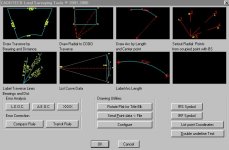BruceR
Gold Member
- Joined
- Aug 31, 2005
- Messages
- 435
- Location
- East Texas
- Tractor
- YM 2000B, JD 110, cub cadet 109, cub cadet 70, cub cadet 100
zeuspaul said:TN should be able to find his corners with a tape measure. A tape measure can be used for just distances or it can also be used to develop angles too.
The recommendations are to help him find the corners of his property that has already been surveyed.... recon as noted by BruceR. However recon can lead to the discovery of the original monuments and then TN would have a good basis for knowing where his property lines are.
Even if he finds the original monuments they may not represent the true lines. If there is a conflict with a neighboring piece of property the neighbor's property may or may not take precedence.
Zeuspaul
The tape measure is OK for small lots but I need to see someone carry it out for a couple thousand feet before I will believe it can be done. If trying to tape or "chain" the distances you will need a 100' steel surveyors tape ( pick it up used on ebay ) and be sure to apply the proper tension (to compensate for sag) and to keep it level, plumbing it if going up or down hill.
It is true that Junior/Senior rights can come into play here. The deed to this tract and all the adjoining tracts probably need to be run back to the soverign. All the more reason to try and find someone with a history in your area who may have already done all of that, or go down to the courthouse and start pulling deeds. Some of the adjoiners deeds may show witness trees near your corners which you can then strap distances from to locate your corners.
This is an old property description which was probably run out with a compass and chain. The 1/2 degrees and 1/2 rods may well be the result of someone having already done their best to balance the traverse. The distances called for may well be short by a couple of hundred feet, that is usually the case in my area as the person purchasing the land was often pressed into service as tail chainman to try and keep the surveying cost down. It didn't take them long to figure out that if the took an extra step before they hollered "CHAIN" that they would wind up with more land than they were paying for. Also when they original tracts were carved from the soverign the surveyors would make sure there was some extra, as land was cheap and they didn't want to cheat the purchaser out of any by mistake.
Boundary re-construction is my passion, much more money in construction surveying or city surveying but it's parcels such as these that keep me interested.
On another note, the road may well have moved since this description was written since as it was probably more of a cart trail at the time. The parcel lines may also have old cart trails along them as well as it was often the custom to use the line the surveyors cleared as a road between two large tracts. Look for a depression or a hump with a ditch on either side apprx. 6-12 foot wide, don't be mislead by the timber, there may well be trees 24" or greater dia. growing there at this point. Look for blazed trees, these would have a blaze facing the line if they were within 4 foot of either side of it or a blaze on line if the tree was on the line. Trees with an "X" will indicate a corner. Trees with an "X" and hacks above and below or base blazed trees will indicate that it is a Witness tree for the corner. Get down and squint and try to see a difference in the timber, one tract or the other was probably logged in the past and you may well be able to discern a difference. If sassafrass gows in your area look for stands of sassafrass trees. These typically grow in open areas along the edges of fields. If the field lays fallow and timber grows, the sassafrass will remain. Look for a line of trees larger in dia. than the rest, that would indicate the location of the line, there may well be two lines 6-12 feet apart, this would also indicate an old road between two tracts.
If you try to run this out with a compass be sure you are familiar with declination and how to apply it to your compass readings. Don't rely on what a USC&GS based topo tells you the declination is, they are probably twenty years old and your declination will have changed considerably since then. I do solar observations to determined "True Bearing" and adjust my declination to match.
Take this as an oportunity to go and meet the neighbors, maybe they have knowledge of the location of the lines.
In this case, mathematics and sat photos will get you started in the right direction but you have to get down in the dirt and gather the true evidence of the line. If the trees called for at the corners are gone, you should still be able to locate the stump holes. I'm not sure what a wild Cherry root tastes like, but pine tastes like turpentine.
Bruce

